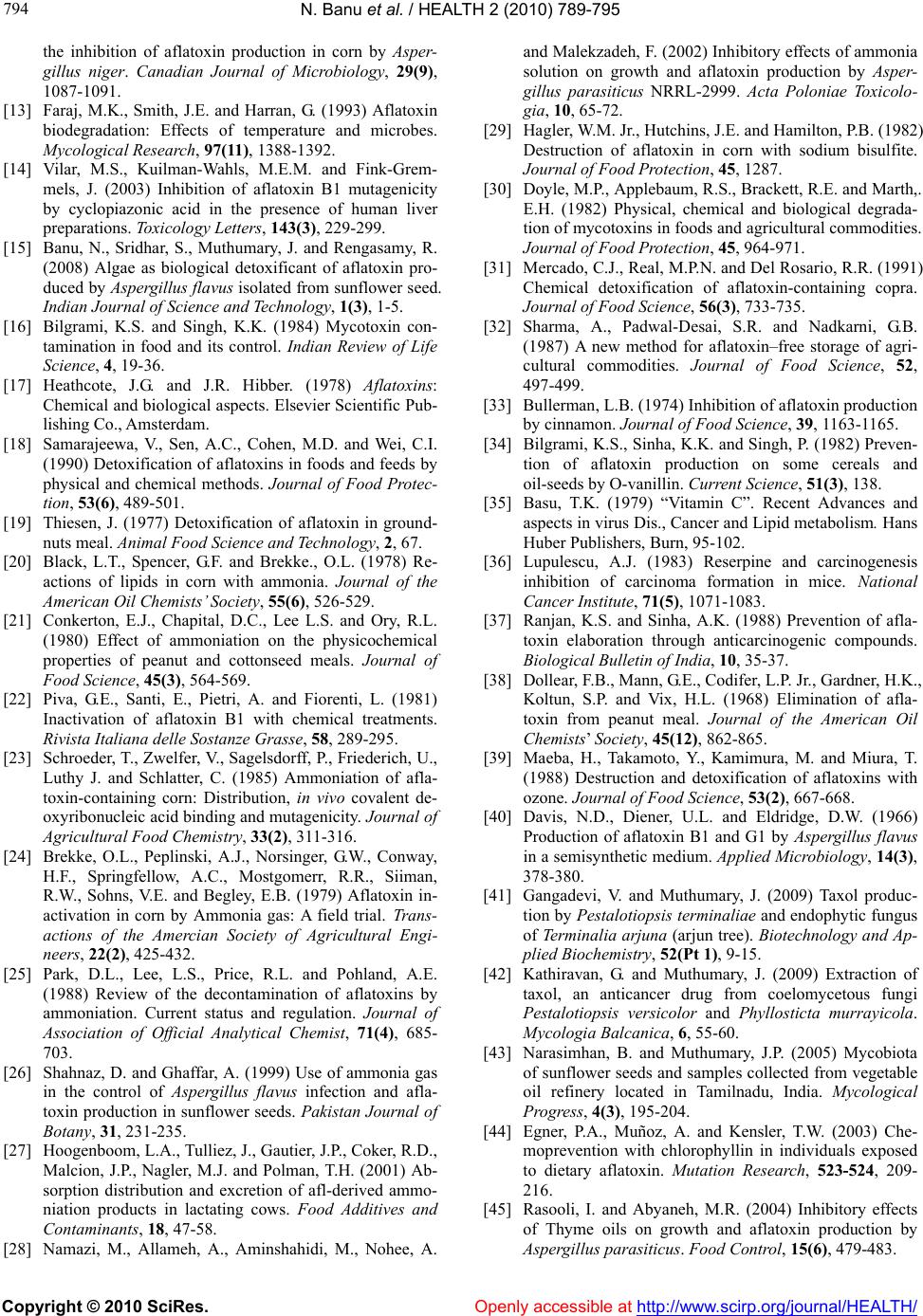
N. Banu et al. / HEALTH 2 (2010) 789-795
Copyright © 2010 SciRes. Openly accessible at http://www.scirp.org/journal/HEALTH/
794
the inhibition of aflatoxin production in corn by Asper-
gillus niger. Canadian Journal of Microbiology, 29(9),
1087-1091.
[13] Faraj, M.K., Smith, J.E. and Harran, G. (1993) Aflatoxin
biodegradation: Effects of temperature and microbes.
Mycological Research, 97(11), 1388-1392.
[14] Vilar, M.S., Kuilman-Wahls, M.E.M. and Fink-Grem-
mels, J. (2003) Inhibition of aflatoxin B1 mutagenicity
by cyclopiazonic acid in the presence of human liver
preparations. Toxicology Letters, 143(3), 229-299.
[15] Banu, N., Sridhar, S., Muthumary, J. and Rengasamy, R.
(2008) Algae as biological detoxificant of aflatoxin pro-
duced by Aspergillus flavus isolated from sunflower seed.
Indian Journal of Science and Technology, 1(3), 1-5.
[16] Bilgrami, K.S. and Singh, K.K. (1984) Mycotoxin con-
tamination in food and its control. Indian Review of Life
Science, 4, 19-36.
[17] Heathcote, J.G. and J.R. Hibber. (1978) Aflatoxins:
Chemical and biological aspects. Elsevier Scientific Pub-
lishing Co., Amsterdam.
[18] Samarajeewa, V., Sen, A.C., Cohen, M.D. and Wei, C.I.
(1990) Detoxification of aflatoxins in foods and feeds by
physical and chemical methods. Journal of Food Protec-
tion, 53(6), 489-501.
[19] Thiesen, J. (1977) Detoxification of aflatoxin in ground-
nuts meal. Animal Food Science and Technology, 2, 67.
[20] Black, L.T., Spencer, G.F. and Brekke., O.L. (1978) Re-
actions of lipids in corn with ammonia. Journal of the
American Oil Chemists’ Society, 55(6), 526-529.
[21] Conkerton, E.J., Chapital, D.C., Lee L.S. and Ory, R.L.
(1980) Effect of ammoniation on the physicochemical
properties of peanut and cottonseed meals. Journal of
Food Science, 45(3), 564-569.
[22] Piva, G.E., Santi, E., Pietri, A. and Fiorenti, L. (1981)
Inactivation of aflatoxin B1 with chemical treatments.
Rivista Italiana delle Sostanze Grasse, 58, 289-295.
[23] Schroeder, T., Zwelfe r, V., Sagelsdorff, P., Friederich, U.,
Luthy J. and Schlatter, C. (1985) Ammoniation of afla-
toxin-containing corn: Distribution, in vivo covalent de-
oxyribonucleic acid binding and mutagenicity. Journal of
Agricultural Food Chemistry, 33(2), 311-316.
[24] Brekke, O.L., Peplinski, A.J., Norsinger, G.W., Conway,
H.F., Springfellow, A.C., Mostgomerr, R.R., Siiman,
R.W., Sohns, V.E. and Begley, E.B. (1979) Aflatoxin in-
activation in corn by Ammonia gas: A field trial. Trans-
actions of the Amercian Society of Agricultural Engi-
neers, 22(2), 425-432.
[25] Park, D.L., Lee, L.S., Price, R.L. and Pohland, A.E.
(1988) Review of the decontamination of aflatoxins by
ammoniation. Current status and regulation. Journal of
Association of Official Analytical Chemist, 71(4), 685-
703.
[26] Shahnaz, D. and Ghaffar, A. (1999) Use of ammonia gas
in the control of Aspergillus flavus infection and afla-
toxin production in sunflower seeds. Pakistan Journal of
Botany, 31, 231-235.
[27] Hoogenboom, L.A., Tulliez, J., Gautier, J.P., Coker, R.D.,
Malcion, J.P., Nagler, M.J. and Polman, T.H. (2001) Ab-
sorption distribution and excretion of afl-derived ammo-
niation products in lactating cows. Food Additives and
Contaminants, 18, 47-58.
[28] Namazi, M., Allameh, A., Aminshahidi, M., Nohee, A.
and Malekzadeh, F. (2002) Inhibitory effects of ammonia
solution on growth and aflatoxin production by Asper-
gillus parasiticus NRRL-2999. Acta Poloniae Toxicolo-
gia, 10, 65-72.
[29] Hagler, W. M. Jr., Hutchins, J.E. and Hamilton, P.B. (1982)
Destruction of aflatoxin in corn with sodium bisulfite.
Journal of Food Protection, 45, 1287.
[30] Doyle, M.P., Applebaum, R.S., Brackett, R.E. and Marth,.
E.H. (1982) Physical, chemical and biological degrada-
tion of mycotoxins in foods and agricultural commodities.
Journal of Food Protection, 45, 964-971.
[31] Mercado, C.J., Real, M.P.N. and Del Rosario, R.R. (1991)
Chemical detoxification of aflatoxin-containing copra.
Journal of Food Science, 56(3), 733-735.
[32] Sharma, A., Padwal-Desai, S.R. and Nadkarni, G.B.
(1987) A new method for aflatoxin–free storage of agri-
cultural commodities. Journal of Food Science, 52,
497-499.
[33] Bullerman, L.B. (1974) Inhibition of aflatoxin production
by cinnamon. Journal of Food Science, 39, 1163-1165.
[34] Bilgrami, K.S., Sinha, K.K. and Singh, P. (1982) Preven-
tion of aflatoxin production on some cereals and
oil-seeds by O-vanillin. Cur rent Science, 51(3), 138.
[35] Basu, T.K. (1979) “Vitamin C”. Recent Advances and
aspects in virus Dis., Cancer and Lipid metabolism. Hans
Huber Publishers, Burn, 95-102.
[36] Lupulescu, A.J. (1983) Reserpine and carcinogenesis
inhibition of carcinoma formation in mice. National
Cancer Institute, 71(5), 1071-1083.
[37] Ranjan, K.S. and Sinha, A.K. (1988) Prevention of afla-
toxin elaboration through anticarcinogenic compounds.
Biological Bulletin of India, 10, 35-37.
[38] Dollear, F.B., Mann, G. E., Codi fe r, L.P. Jr., Gardner, H.K.,
Koltun, S.P. and Vix, H.L. (1968) Elimination of afla-
toxin from peanut meal. Journal of the American Oil
Chemists’ Society, 45(12), 862-865.
[39] Maeba, H., Takamoto, Y., Kamimura, M. and Miura, T.
(1988) Destruction and detoxification of aflatoxins with
ozone. Journal of Food Science, 53(2), 667-668.
[40] Davis, N.D., Diener, U.L. and Eldridge, D.W. (1966)
Production of aflatoxin B1 and G1 by Aspergillus flavus
in a semisynthetic medium. Applied Microbiology, 14(3),
378-380.
[41] Gangadevi, V. and Muthumary, J. (2009) Taxol produc-
tion by Pestalotiopsis terminaliae and endophytic fungus
of Terminalia arjuna (arjun tree). Biotechnology and Ap-
plied B iochemi stry, 52(Pt 1), 9-15.
[42] Kathiravan, G. and Muthumary, J. (2009) Extraction of
taxol, an anticancer drug from coelomycetous fungi
Pestalotiopsis versicolor and Phyllosticta murrayicola.
Mycologia Balcanica, 6, 55-60.
[43] Narasimhan, B. and Muthumary, J.P. (2005) Mycobiota
of sunflower seeds and samples collected from vegetable
oil refinery located in Tamilnadu, India. Mycological
Progress, 4(3), 195-204.
[44] Egner, P.A., Muñoz, A. and Kensler, T.W. (2003) Che-
moprevention with chlorophyllin in individuals exposed
to dietary aflatoxin. Mutation Research, 523-524, 209-
216.
[45] Rasooli, I. and Abyaneh, M.R. (2004) Inhibitory effects
of Thyme oils on growth and aflatoxin production by
Aspergillus parasiticus. Food Control, 15(6), 479-483.